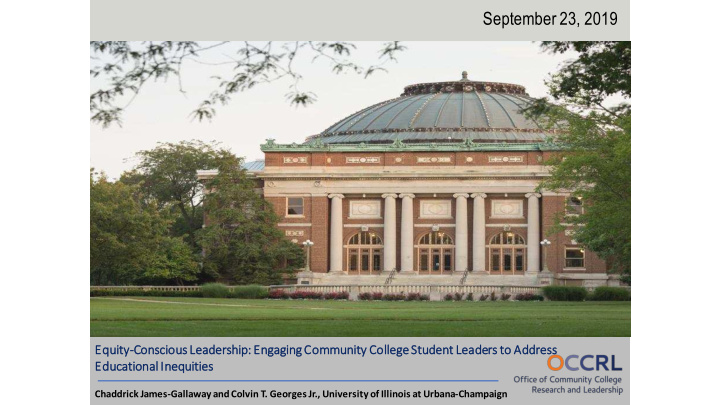



September 23, 2019 Equity-ConsciousLeadership: Engaging Commu munity College Student Lea Leaders to Address Educational Inequities LSCME Webinar Chaddrick James-Gallaway andColvin T. Georges Jr., University of Illinois at Urbana-Champaign
OCCRL’s Mission OCCRL researchers study policies, programs, and practices designed to enhance outcomes for diverse youth and adults who seek to transition to and through college to employment. Strengthening Pathways for All Students Through Research and Leadership @OCCRL
Candy Introductions • Please take 3 Pieces of Candy • Do not eat the candy yet! • For each piece of candy, • Introduce yourself, name your community college, & major.
STUDENT VOICE SOCIAL IDENTITIES Why you are here? EQUITY
Board of Trustees Delta College (My Community College)
What is Student Voice? • Student voice refers to the values, opinions, beliefs, perspectives, and cultural backgrounds of individual students and groups of students in a school, and to instructional approaches and techniques that are based on student choices, interests, passions, and ambitions.
The importance of student voice: Donivan Ryan at TEDxRockyViewSchoolsED • Student voice has been shown to positively impact and increase student engagement as well as achievement as students feel a partnership and have ownership in their learning experiences and campus community.
Student Voice Video Reflection • What did you hear in the video that was relevant to you? • Do you believe that students should affect the community colleges they attend? • Quote “If we cannot change our schools how can we change the world.” • What are your thoughts about this quote. • Students are the consumers of decisions being made by the board of trustees. What will your roll be in making sure you represent the voices of all students at your campus?
Where Are You On The Student Voice Ladder? Retcher, A. (2011). Student Voice Ladder . Adapted from Hart et, al. (1994) photograph.
Exploring Student Leadership Jigsaw Activity • Divide into groups of 2-3 people. • Elect a scribe, group presenters, and group leader • You will be given 10 minutes to read over your group’s article • You will be given 5 mins to write or draw key points on a large post-it note • Afterwards your group presenters will share out to the class.
Who do you represent? • 1) Student Government Association members, attached faculty advisors and the outgoing Student Trustee. • 2) Club members and faculty advisors. • 3) Current board members and the president. • 4) The board secretary. (He, she or they is important enough to get a separate bullet point!) • 5) The student body at large. Go out and meet them, making a point of going to every campus as well.
• What are the different needs in the community? • Are the educational programs meeting community needs? What You Will • Who are the different groups in the community that Need to Know should be served by the college? • What are the economic, social and demographic trends in You need to your community that have implications for education? • You need to know about the college district. What are its know about mission and goals? What are the major issues facing the college? your • You need to know about the district’s students. What are the different needs of the wide variety of students that community? attend the college(s) in the district? • Are students well-served by the college(s)? Are they succeeding?
Social Identities and Equity-Conscious Leadership
Social Identity Wheel Activity
• We define educational equity as the process of identifying how disparities affect the educational opportunities of students based on Centering marginalized social identities (i.e. race, gender, socioeconomic class, sexuality, age, citizenship, Equity religion, physical and mental ability, etc.) and subsequently developing strategic solutions to take systemic action to redress these inequities.
Equity Vs Equality
Race for Equity in Education
Concluding Thoughts
Recommend
More recommend